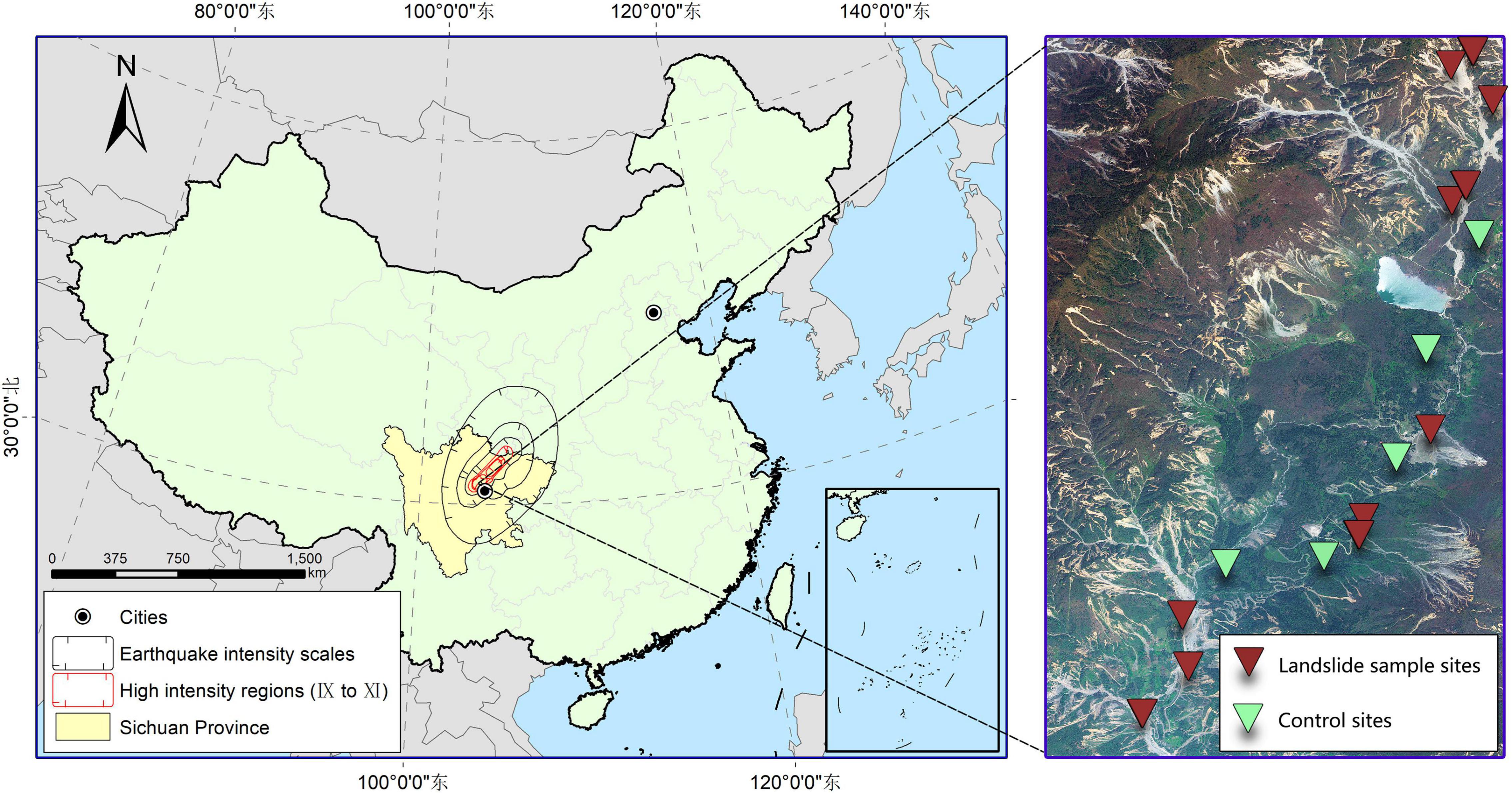- 1Key Laboratory of Southwest China Wildlife Resources Conservation (Ministry of Education), China West Normal University, Nanchong, China
- 2The Research Center of Recycle Agricultural Engineering and Technology of Shaanxi Province, Yangling, China
- 3Longxi-Hongkou Nature Reserve Administration, Chengdu, China
Regeneration and assembly of a plant community after a large-scale natural disturbance are affected by many factors. The relative importance of abiotic factors represented by the external environment and the biological factors inside the plant community during this process is still unexplored. This work investigated the regions affected by the Wenchuan earthquake, focusing on areas with the highest intensity (XI degrees) of this earthquake, and the process of community assembly through functional traits on landslides. The aim of this study was to understand the importance of factors influencing community assembly from the perspective of functional traits. The main conclusion is presented as follows: after the regeneration of large earthquake-induced landslides, community-level functional traits covering many plant organs, such as roots, stems, leaves and seeds, are obviously different from those unaffected by landslides. Functional traits do not show strong phylogenetic conservatism. Overall, community traits are divergent or random, and the degree of divergence among the different traits varies. Species composition and alpha diversity have minimal effect on community functional traits during the process of landslide restoration. Landslide scale and altitude significantly affected community-level functional traits in the process of community assembly. All the findings suggested that the functional traits of regenerating vegetation after the earthquake changed significantly and that the functional traits depended more on abiotic regulation than on evolutionary and species-specific factors.
Introduction
The process and mechanisms that drive community assembly have been a long-standing, central theme of ecology (Tilman, 2004; Kraft et al., 2008; Mouchet et al., 2010). Plant functional traits coordinate with the environment and are the result of long-term adaptive evolution (Díaz et al., 1998; Dante and Sandra, 2020). Differences in plant functional traits can objectively express not only plant physiological processes but also interactive processes with the external environment of a plant (McGill et al., 2006). At the community scale, for example, if functional traits are more aggregated than those of a null model, then community assembly is dominated by environmental filtering. However, if the community-scale functional traits are more divergent than those of the null model, then the limiting similarity is very important in the process of community assembly. The abovementioned models have been widely employed for stable environments and ideal succession processes (Blomberg et al., 2003; Swenson and Enquist, 2009; Swenson, 2011; Zhang et al., 2020). However, ecosystems are open systems that are generally influenced by various factors (Sousa, 1984; Keddy, 2012). Disturbances impact not only the physiological and ecological processes of plants but also community dynamics and act as selective forces in species composition (Sousa, 1984; Dante and Sandra, 2020). Research shows that disturbances can cause changes in the neutral processes of community assembly and the relative importance of niche processes, and differences in disturbance intensity can cause communities to follow different assembly processes (Mengjun et al., 2012; Han et al., 2018). Large-scale natural disturbances have high intensity and uncontrollable risk and cannot be eliminated by management. It is important to study community assembly mechanisms following disturbances to accelerate recovery after such disturbances and to reduce ecological risks (Keddy, 2012).
Earthquakes, which are related to the natural movements of the earth’s interior, cause global environmental disturbances and are an inevitable ecological process, resulting in the degradation of ecosystem structure and function (Allen et al., 1999; Wells et al., 2001; Cui et al., 2012). However, the coexistence of degradation and regeneration provides an opportunity for the evolution of plants. Therefore, community assembly after earthquakes has always been a controversial topic in environmental science, geoscience and ecology (Lu et al., 2012; Marín et al., 2014). A large number of previous studies relied on remote sensing technology to investigate vegetation restoration and landscape changes (Zhang et al., 2011; Gan et al., 2019), but in-depth studies within communities are lacking. Some researchers have focused on communities that regenerated after earthquakes but have mostly reported on species composition and diversity (Zhang et al., 2014; Huang et al., 2017). Assessments of the processes and mechanisms of community assembly after earthquakes based on functional traits are still lacking, especially assessments that are linked to indicators of damage intensity, such as landslide scales.
The Wenchuan 8.0 earthquake in China, which occurred on May 12, 2008, caused a large number of landslides and serious ecosystem degradation. To study the process of community assembly and factors influencing it using phylogeny and functional traits on regenerating landslides, we selected sixty-five plots at 11 typical landslide sites in the regions affected by the Wenchuan earthquake with the highest intensity (XI). We hypothesized that earthquakes can cause changes in the functional traits of local plant communities and that these changes will be more affected by abiotic factors such as landslide scales. This hypothesis is developed from our previous findings that community phylogenetic structure responded sensitively to altitude and landslide scales in this region (Kang et al., 2021). This study can offer support for clarifying the mechanisms of community assembly and evolutionary mechanisms under strong natural disturbance.
Materials and Methods
Study Area
This study was carried out in the Longxi-Hong Kou National Natural Reserve (103°32′E–103°43′E, 31°04′N–31°22′N) of China, which was the region with the highest earthquake intensity (XI degrees) in the Wenchuan earthquake (Figure 1). This natural reserve covers 310 km2 and has an altitude of 850–4,582 m and a maximum relative elevation of 3,700 m. The area is characterized by a subtropical humid monsoon climate. The mean annual temperature ranges from 10° to 15°C, with a maximum of 25°C in summer and a minimum of −10°C in winter. The mean annual relative humidity is more than 80%, and the mean annual precipitation ranges from about 800 to 1,500 mm, with the main precipitation occurring from March to September. Please see Supplementary Table 2 in the Supplementary Material for detailed meteorological information. The vegetation prior to the landslides was secondary forest, and the average height, diameter at breast height, and density of standing trees were 9.85 m, 15.4 cm, and 551/ha, respectively, dominated by Cryptomeria japonica, Lindera obtusiloba, Litsea moupinensis, Meliosma cuneifolia, Toxicodendron vernicifluum, Houpoea officinalis, and Acer laxiflorum.
Selection of Sample Sites
Eleven typical landslide masses and five sites unaffected by landslides in the same watershed were selected; the landslides were separated by a distance greater than 110 m but less than 2,500 m (for detailed information about sample sites, please refer to Supplementary Tables 2A,B in the Supplementary Material). All the selected landslides were larger than 500 m2. It must be ensured that the landslide was caused by the main shock of the Wenchuan earthquake in May 2008 and not by any other earthquake. This information can be determined based on remote sensing images before and after the Wenchuan earthquake to ensure that all study sites had similar ecological backgrounds. Sixty-five regenerating sample plots were established on the typical landslide masses. Each of the plots comprised an area of 5 m × 5 m for woody plant measurement, and five 1 m × 1 m subplots were established for herbaceous plant measurement in each plot (with four subplots in the four corners and the 5th subplot in the center). Fifteen sample plots in the sites unaffected by landslides were selected, and the method of subplot selection was consistent with those on the landslides. For each plot, the name and abundance of each species were recorded. All field sampling work was completed in June 2019.
Identification of Functional Traits
Following the protocols of Pérez-Harguindeguy et al. (2013), the following plant traits were collected in the sample sites. Specific leaf area (SLA, cm2 g–1) was measured using a leaf area meter in the field. The leaves were brought back to the laboratory soon after field measurement and were oven-dried for 40 min at 105°C, after which they were dried to a constant weight at 80°C and weighed. To measure leaf dry matter content (LDMC, mg g–1), the collected fresh leaves were soaked in distilled water and placed in a dark environment at 5°C for 12 h. The fresh weight was obtained, and then the dry weight was measured after drying; LDMC = dry weight/fresh weight × 100%. To determine stem density (SDY, g cm–3, only for woody species), the stem volume was measured by the drainage method; then, the stems were oven-dried for 40 min at 105°C, dried to a constant weight at 80°C and weighed (SDY = dry weight/volume). To determine specific root length (SRL, cm g–1, only for herbaceous species), the total root length was measured by winRHIZO root image analysis system (Regent Instruments Canada Inc.). The samples were then dried to a constant weight at 60°C and weighed (SRL = total root length/dry weight). Leaf thickness (LT, mm), average plant height (APH, cm), crown diameter (CD, m), and thousand kernel weight (TKW, g) were measured using conventional tools in the field. The above-mentioned traits provide a thorough description of plant leaves, stems, roots and reproductive traits and can comprehensively reflect the functional characteristics of a community. Functional traits at community scale were weighted according to the importance value of each species in each community.
Geographical Factors of Landslides
For a better understanding of the geographical factors that influence the functional traits of regenerating communities on landslides, we selected altitude (ATT, m), slope (SLO, degree) and slope aspect (TRASP, transformation of aspect) to describe the new environmental characteristics after landslide formation. The slope aspect is often recorded in degrees (1–360°) and used to describe light conditions on slopes. However, 1 and 360° often have the same ecological meaning, and these data are not suitable for fitting with other continuous variables. Thus, we used TRASP (transformation of aspect) to avoid these limitations (Roberts and Cooper, 1989; Martinez et al., 2019); the formula for TRASP is as follows:
In this formula, angle (ranging from 1 to 360°) is transformed into a value from 0 to 1 to explain the dry or wet environmental conditions of the slope. TRASP values close to 1 indicate a drier and hotter environment, while TRASP values close to 0 indicate a wetter and colder environment.
Furthermore, the length(LML) and width(LMW) of each landslide mass (a schematic diagram explaining the LML and LMW sampling standards can be found in Supplementary Figure 1 in the Supplementary Material) were recorded to determine the landslide scale (i.e., the intensity of environmental fluctuation) and provide a better understanding of the natural disturbance-restoration process after an earthquake.
Alpha Diversity Index
For a better understanding of how alpha diversity influences community functional traits, the species richness (dMa), Simpson index (Dr), Shannon index (He) and Pielou index (Je) were
calculated to describe the biodiversity of the sample sites. The calculations are as follows:
In the formulas above, S is the number of species in a given plot, ni is the abundance of species (i), and N is the sum of the number of species.
Phylogenetic Tree and Phylogenetic Signal of Traits
Before the Zanne backbone (Zanne et al., 2014) publication, Phylomatic software (Webb et al., 2008) could be used to construct trees without node ages. Since 2015, the Zanne backbone has been embedded into Phylomatic (V3),1 and Phylomatic can construct trees including node ages, as was done in this study. All the species found in the sample sites were included in the process of tree construction and were classified according to the Angiosperm Phylogeny Group (APG IV) classification system. The phylogenetic tree is shown in Supplementary Figure 2 in the Supplementary Material.
Phylogenetic signals of functional traits based on Blomberg’s K were used to detect the potential differences in patterns of phylogenetic and functional structures (Blomberg et al., 2003). To evaluate the trait-phylogeny relationship with the alpha diversity and geographical characteristics of the regenerating communities on the landslides, we calculated Blomberg’s K to assess the phylogenetic conservatism of each trait for each sample plot. Significance was estimated through 999 randomizations, with the trait distribution randomly shuffled across phylogenetic tips. All the trait data were transformed using an extreme method for non-dimensionality before analysis. We determined Blomberg’s K and its significance by using the Kcalc, phylosignal, and multiphylosignal functions in the R package picante.
Statistical Analyses
Generalized linear mixed model (GLMM) was applied to study the effects of alpha diversity and the geographical characteristics of the landslides on the functional traits of the regenerating communities. In the GLMM, each trait was regarded as a dependent variable, with which a model with influencing factors was constructed. To better understand the impact of site differences on the results, factors were regarded as fixed effect, and ID of sample sites were regarded as random effect. Akaike’s information criterion corrected (AICc), which balances the fit of the model against the number of parameters, was used to select the model with the best fit (Anderson and Burnham, 2001). The model with the lowest AICc value was accepted as the model with the best fit for the data. Since the values of functional traits exhibited a Gaussian distribution, an identity link function in GLMM was used. The standardized coefficient was regarded as the size of the factor’s influence, and a total of 999 random simulations were performed for each calculation to obtain a 95% confidence interval. The GLMM was conducted in IBM SPSS 22 (IBM Corp.), and forests were plotted using “forestplot” package in R 4.1.2 and used to show the results. All the abbreviations used in the figures and tables in this work are listed in Supplementary Table 3 in the Supplementary Material.
Results
Characteristics of Community Functional Traits on Regenerating Areas Following Landslides
Weighed functional traits at the community scale were analyzed. The results showed that the specific leaf area and crown diameter of herbaceous plants on the landslides were significantly lower than those not present on landslides (P < 0.001, Figure 2). No significant differences in other traits of herbaceous plants were detected. Specific leaf area, leaf dry matter content, stem density and leaf thickness were significantly higher for woody plants on the landslides than for those not present on the landslides (P < 0.001, Figure 3), and crown diameter and thousand kernel weight were significantly lower for woody plants on the landslides than for those not present on the landslides (crown diameter, P < 0.001; thousand kernel weight, P < 0.001). There were no significant differences in average plant height between the landslide sites and the sites unaffected by landslide.
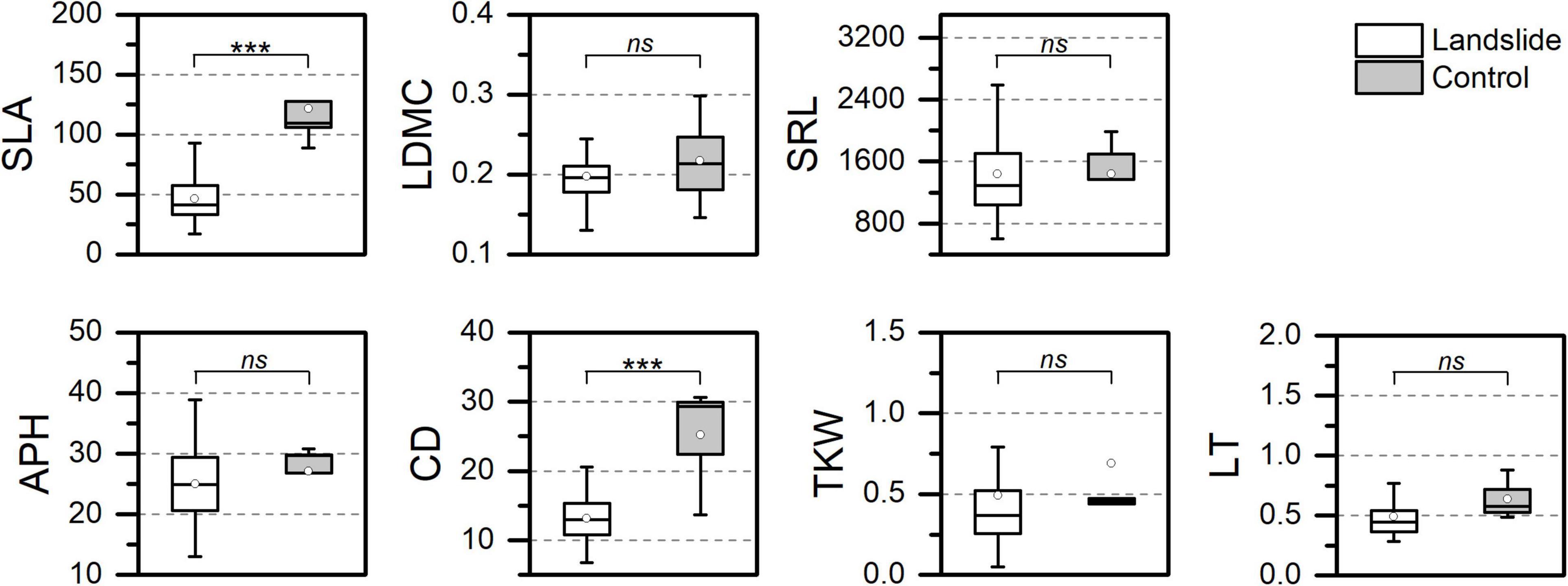
Figure 2. The difference in community functional traits of herbaceous plants between landslide and non-landslide sites. SLA, specific leaf area; LDMC, leaf dry matter content; SRL, specific root length; LT, leaf thickness; APH, average plant height; CD, crown diameter; TKW, thousand kernel weight; ns, non-significant; ***, significant at the 0.01 level.
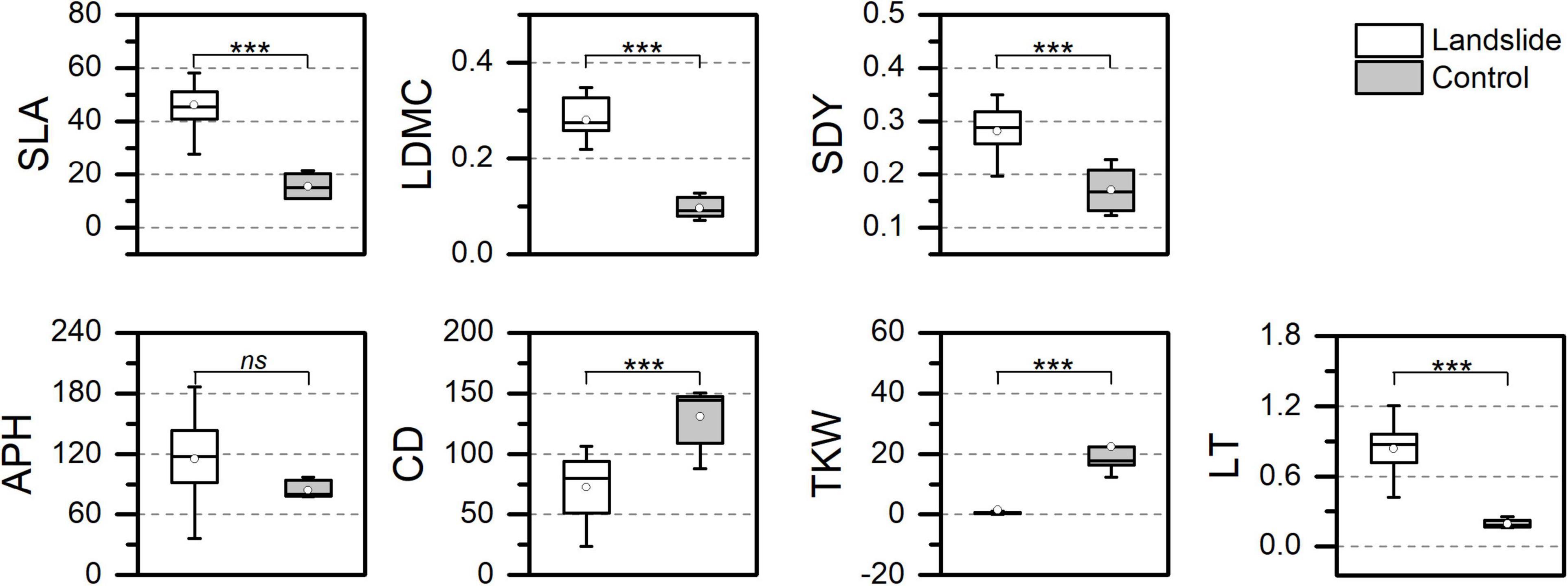
Figure 3. The difference in community functional traits of woody plants between landslide and non-landslide sites. SLA, specific leaf area; LDMC, leaf dry matter content; SDY, stem density; LT, leaf thickness; APH, average plant height; CD, crown diameter; TKW, thousand kernel weight; ns, non-significant; ***, significant at the 0.01 level.
Correlations of functional traits are shown in Figure 4. The results showed that for the herbaceous plants, crown diameter and average plant height were positively correlated with leaf thickness at the 0.05 level, and crown diameter was positively correlated with average plant height at the 0.01 level. No significant correlation among the other functional traits was observed. For the woody plants, average plant height was positively correlated with crown diameter at the 0.01 level; specific leaf area was positively correlated with leaf thickness at the 0.01 level; specific leaf area was negatively correlated with leaf dry matter content at the 0.05 level; and specific leaf area was negatively correlated with stem density at the 0.01 level. No significant correlation among the other functional traits of woody plants was observed.
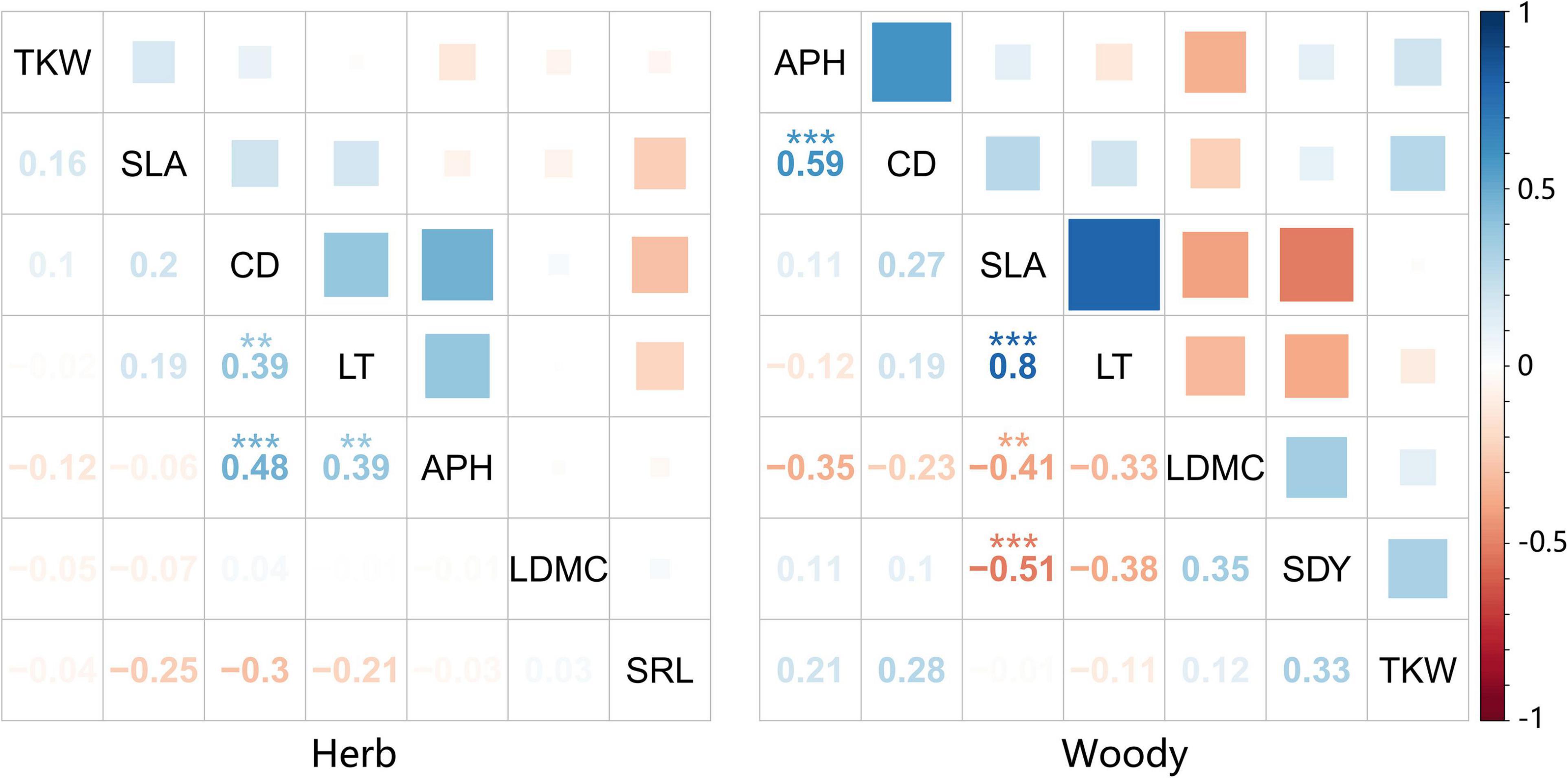
Figure 4. Pearson’s correlation coefficients of functional traits at the community scale. SLA, specific leaf area; LDMC, leaf dry matter content; SRL, specific root length (for herbaceous plants only); SDY, stem density (for woody plants only); LT, leaf thickness; APH, average plant height; CD, crown diameter; TKW, thousand kernel weight; **, significant at the 0.05 level; ***, significant at the 0.01 level.
Phylogenetic Signal of Functional Traits
The phylogenetic signal of the functional traits was measured by using Blomberg’s K-value (Figure 5). The results showed that the phylogenetic signals of all the traits included in this study were lower than 1 on the regenerating landslides, that is, there was no strong phylogenetic conservatism. The thousand kernel weight (P < 0.01) of the herbaceous plants and crown diameter (P < 0.01), leaf dry matter content (P < 0.05), and stem density (P < 0.05) of the woody plants showed significant but weak phylogenetic signals. Notably, the K-values of all the traits with significant phylogenetic signals were higher than 0.5 and lower than 1, which showed a random tendency. The results also indicated that the K-values of most functional traits of the communities on the landslide were lower than those of the control groups.
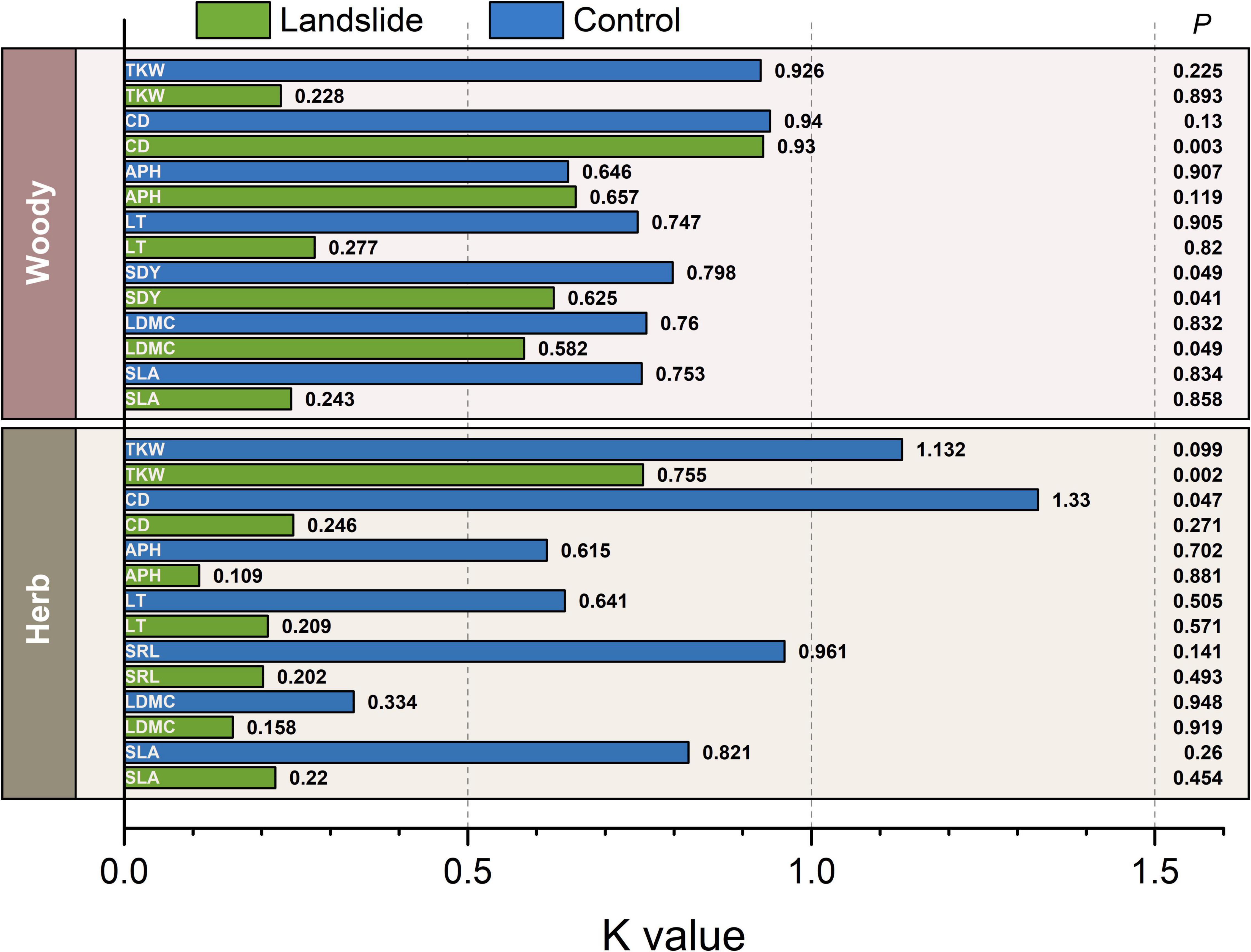
Figure 5. Phylogenetic signals of plant functional traits in communities on landslides based on Blomberg’s K-value. SLA, specific leaf area; LDMC, leaf dry matter content; SRL, specific root length (for herbaceous plants only); SDY, stem density (for woody plants only); LT, leaf thickness; APH, average plant height; CD, crown diameter; TKW, thousand kernel weight.
Factors Influencing Community Functional Traits on Regenerating Landslides
The impact of alpha diversity on community functional traits was measured by using a regression model (Figures 6, 7). The results showed that the leaf dry matter content and specific root length of the herbaceous plants were positively impacted by the species richness (P < 0.05) and that the specific root length and leaf dry matter content were negatively impacted by the Shannon index (P < 0.01). The stem density and leaf dry matter content of the woody plants were negatively impacted by the Simpson index (P < 0.05 and P < 0.01, respectively); the stem density of shrub plants was positively impacted by the Shannon index (P < 0.05); and the specific leaf area and leaf thickness of shrub plants were positively impacted by the Pielou index (P < 0.01 and P < 0.05, respectively). The thousand kernel weight of herbaceous plants was negatively impacted by the Simpson index (P < 0.05). In summary, the community-level alpha diversity had a minimal effect on the functional traits of plants on the regenerating landslides.
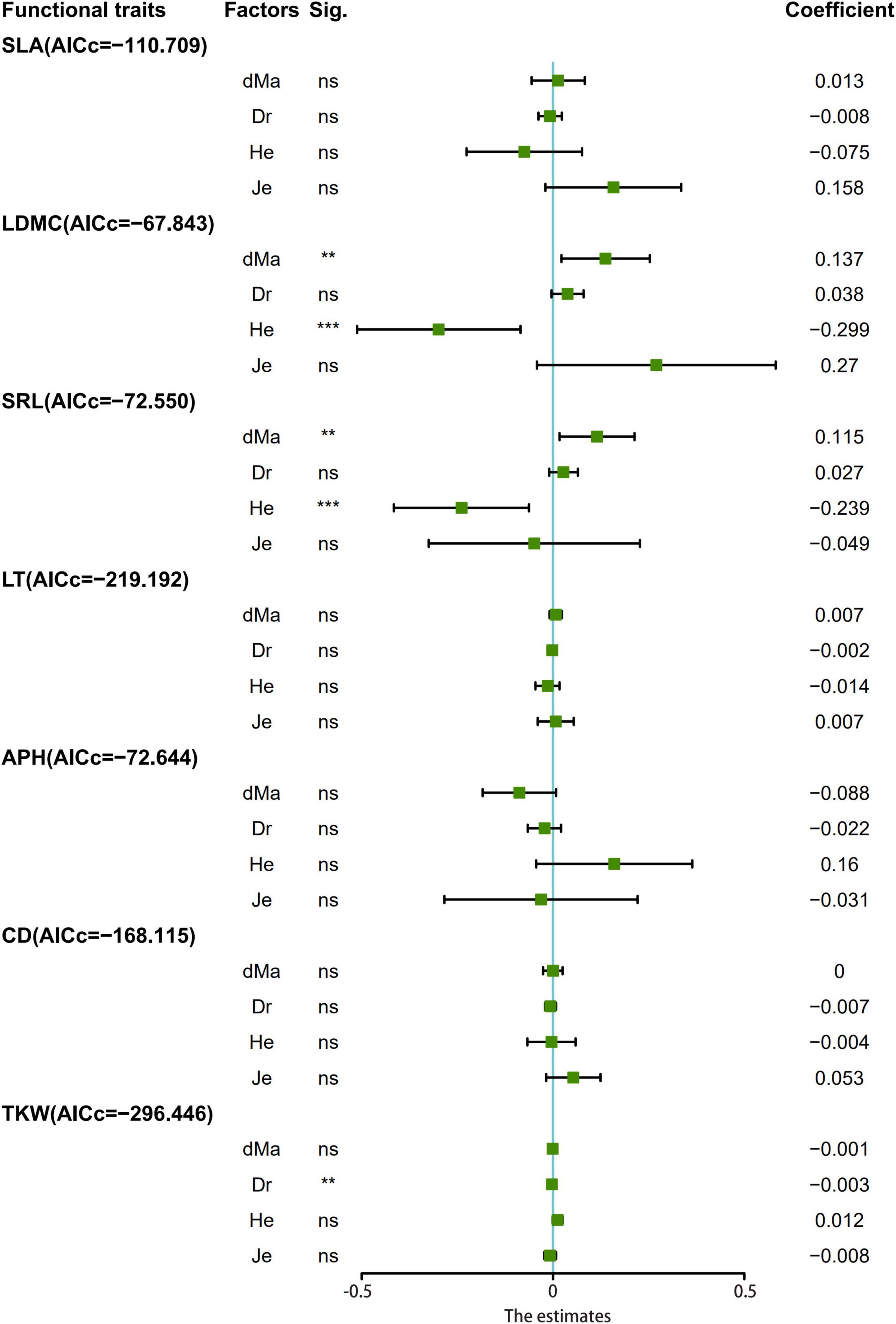
Figure 6. Generalized linear mixed model (GLMM) model coefficient estimates and 95% confidence intervals showing the influence of the alpha diversity of communities on the herb functional traits on the landslides. SLA, specific leaf area; LDMC, leaf dry matter content; SRL, specific root length; LT, leaf thickness; APH, average plant height; CD, crown diameter; TKW, thousand kernel weight; Je, Pielou index; He, Shannon index; Dr, Simpson index; dMa, Margalef index; **, significant at the 0.05 level; ***, significant at the 0.01 level.
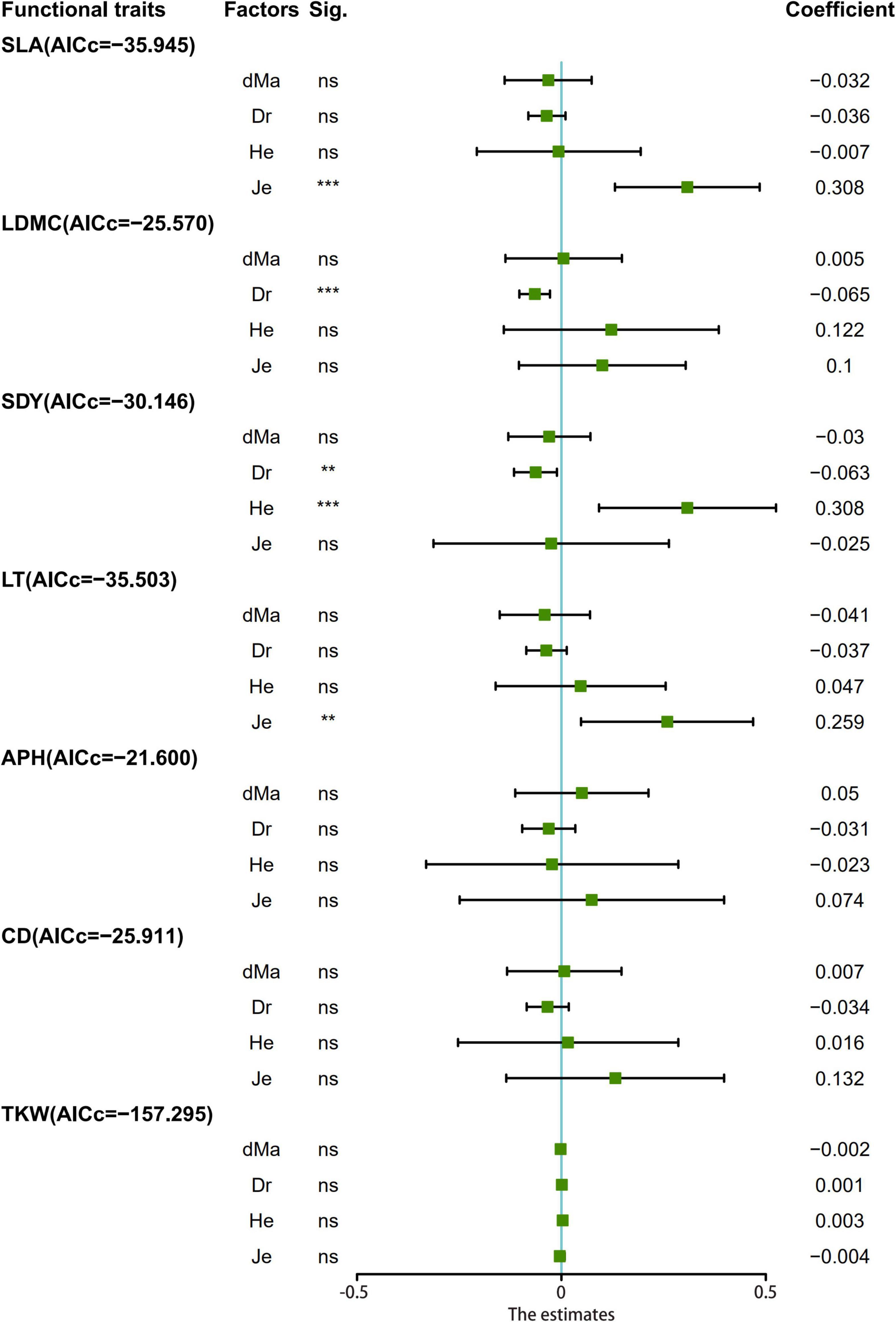
Figure 7. Generalized linear mixed model (GLMM) model coefficient estimates and 95% confidence intervals showing the influence of the alpha diversity of communities no the shrub functional traits on the landslides. SLA, specific leaf area; LDMC, leaf dry matter content; SDY, stem density; LT, leaf thickness; APH, average plant height; CD, crown diameter; TKW, thousand kernel weight; **, significant at the 0.05 level; ***, significant at the 0.01 level.
The impact of the geographical environmental attributes of landslides on community functional traits was measured by using a regression model (Figures 8, 9). The results showed that for the herbaceous plants, the width of landslide mass positively influenced the specific leaf area (P < 0.05) and negatively influenced the average plant height (P < 0.01); altitude positively influenced the specific leaf area and crown diameter (P < 0.01 and P < 0.01, respectively) and negatively influenced the leaf dry matter content and thousand kernel weight (P < 0.01 and P < 0.05, respectively). For the woody plants, the width of the landslide mass positively influenced the leaf dry matter content, average plant height and crown diameter (all P < 0.01); the length of the landslide mass negatively influenced the average plant height and crown diameter at the 0.05 and 0.01 levels; and altitude positively influenced the leaf dry matter content, stem density, average plant height and crown diameter at the 0.01 level. The leaf dry matter content and crown diameter of woody plants in the regenerating community were significantly influenced by most geographical environmental factors. In summary, altitude and landslide scale (landslide width and length) significantly affected the functional traits of the plant communities, while slope aspect and slope degree had no significant effects on the functional traits of the plant communities.
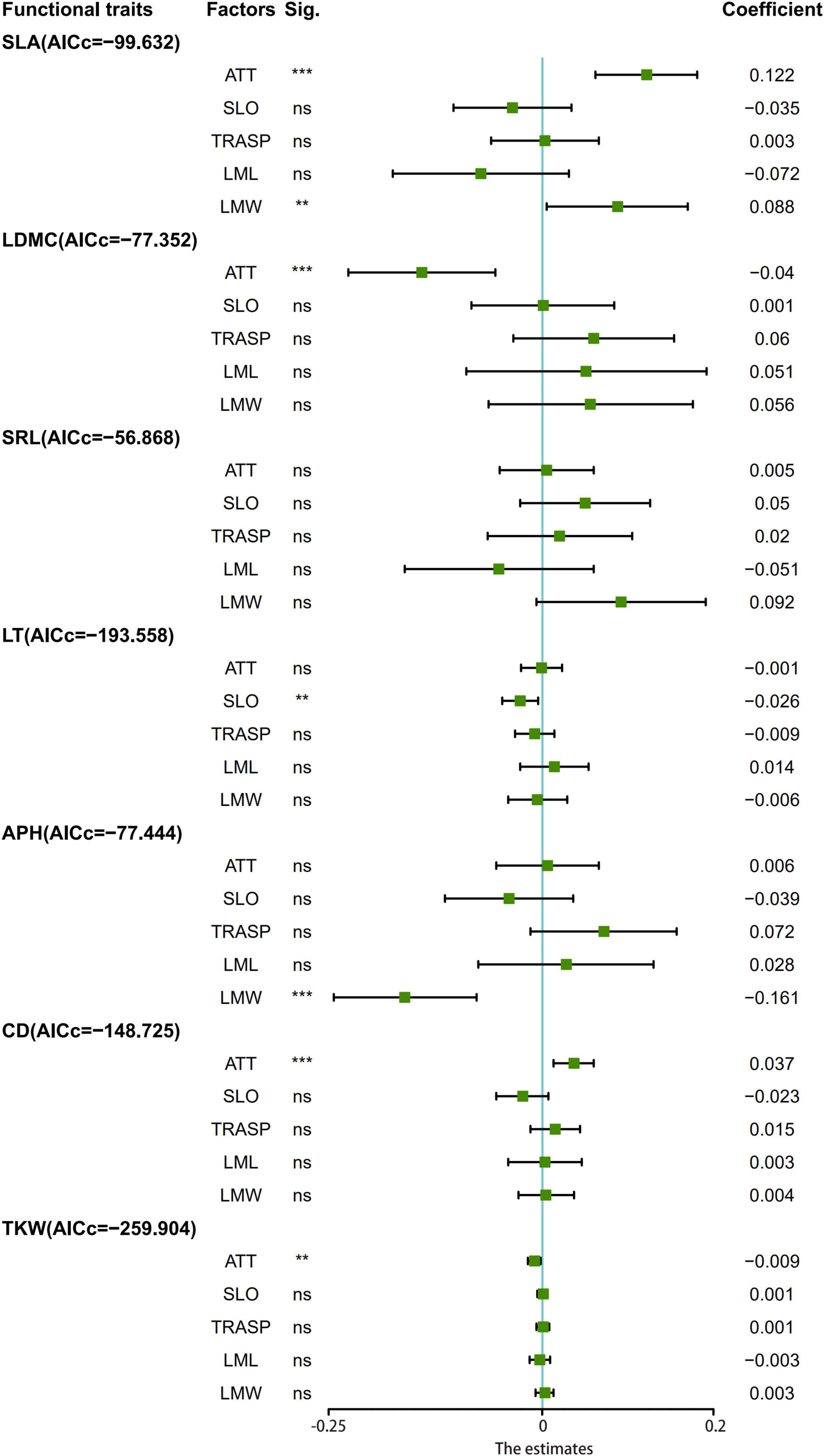
Figure 8. Generalized linear mixed model (GLMM) model coefficient estimates and 95% confidence intervals showing the influence of the geographical environmental attributes of landslide no the herb functional traits. SLA, specific leaf area; LDMC, leaf dry matter content; SRL, specific root length; LT, leaf thickness; APH, average plant height; CD, crown diameter; TKW, thousand kernel weight; ATT, altitude; SLO, slope; TRASP, transformation of aspect; LML, length of landslide mass; LMW, width of landslide mass; **, significant at the 0.05 level; ***, significant at the 0.01 level; ns, non-significant.
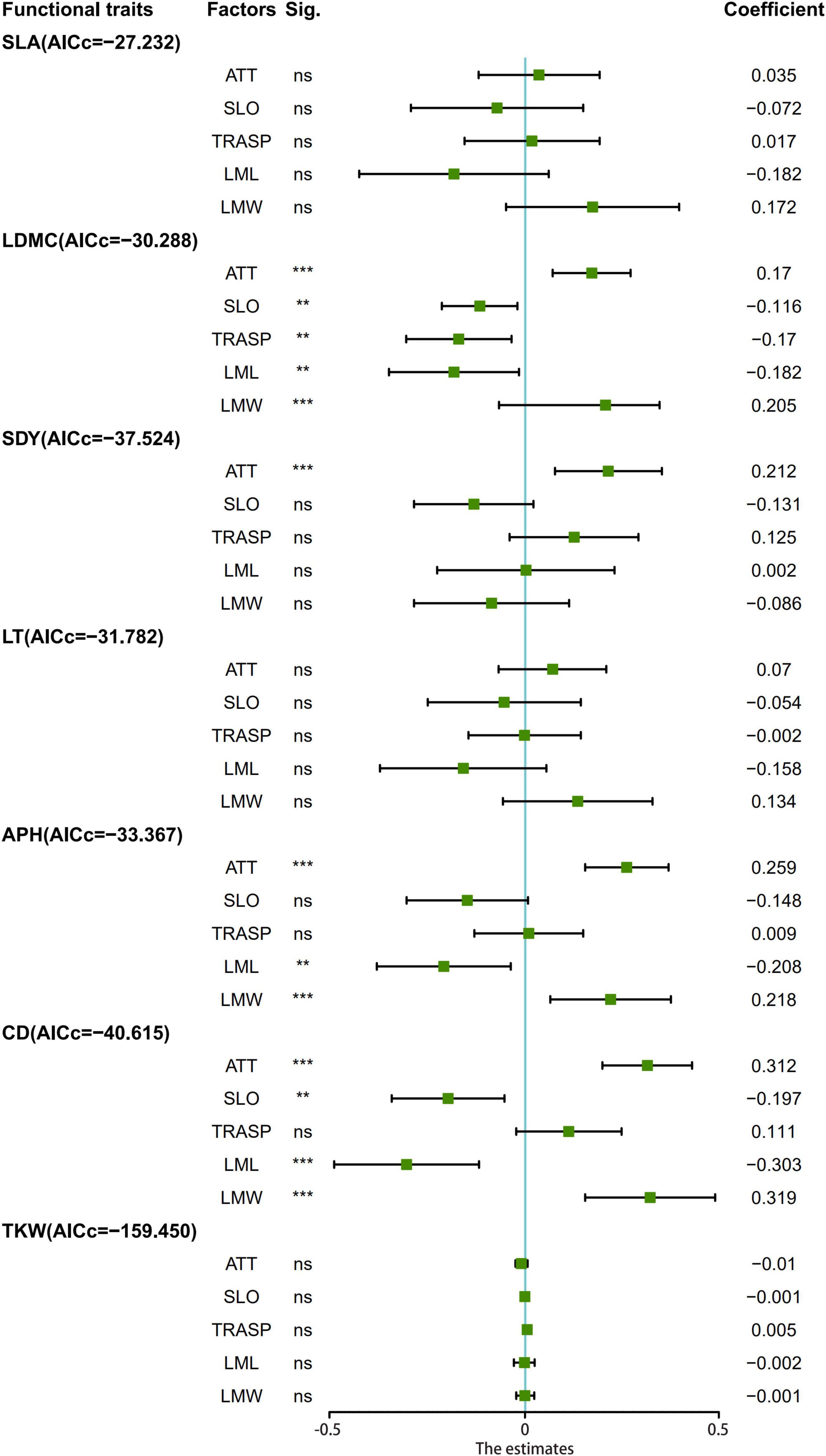
Figure 9. Generalized linear mixed model (GLMM) model coefficient estimates and 95% confidence intervals showing the influence of the geographical environmental attributes of landslide no the shrub functional traits. SLA, specific leaf area; LDMC, leaf dry matter content; SDY, stem density; LT, leaf thickness; APH, average plant height; CD, crown diameter; TKW, thousand kernel weight; **, significant at the 0.05 level; ***, significant at the 0.01 level; ns, non-significant.
Discussion
After the restoration of landslides following large earthquakes, the community-level functional traits of the investigated plants, which represented many plant organs, such as roots, stems, leaves and seeds, were obviously different, and woody plants were more sensitive to the disturbance than herbs. For both the herbaceous plants and woody plants, the crown diameter and specific leaf area were significantly different at the community level after the earthquake. Crown diameter is the main index of community productivity, and reductions in crown size and biomass can reduce transpiration in arid environments in response to drought stress (Jacobs et al., 2021). The reduction in crown diameter is conducive to plants coping with arid environments, and the crown diameter of the herbaceous and woody plants decreased significantly compared with sites unaffected by landslides in this study. Specific leaf area is usually sensitive to environmental conditions; it is an important ecological index for identifying the responses of plants to light sources. Low-light conditions lead to high specific leaf areas to meet plant productivity demands (Ackerly and Cornwell, 2007). It is noteworthy that the specific leaf area changed significantly for both the herbaceous plants and woody plants in this study. The vegetation on a landslide surface is severely degraded and has increased exposure to light. The specific leaf area of the woody plants in this study decreased in accordance with general expectations, while the herbaceous plants showed different responses. In addition, the leaf dry matter content, stem density and leaf thickness of the woody plants on the landslides increased significantly compared with those not present on the landslides (i.e., control group), and plants usually compensate for a lack of resources by increasing their storage of organic matter. The results show that the obvious increase in thousand kernel weight, which shows a trade-off with seed size, will have an effect on the species composition and community structure of the pioneer community (Leishman, 2001; Foster et al., 2004). Seed size has a direct impact on seed dispersal; dispersal restriction is one of the key driving forces of community assembly, and light weights are good for seed dispersal (Zobel, 2001). In conclusion, the changes in community-level functional traits suggest that woody plants are more sensitive to disturbance than herbaceous plants, that is, a larger number of changes in the traits of the woody plants were significant. According to the Pearson correlation analysis, the synergy among woody plant traits is stronger than that among herbaceous plant traits in the earlier stage of landslide succession, which may suggest that the traits of herbaceous plants are more random.
In the study of community assembly mechanisms that are based on phylogenetic relationships and functional traits, there is a very important hypothesis: species with closer phylogenetic relationships are always more similar from an ecological viewpoint, and species in the same genus often have more similar traits than species in different genera (Webb et al., 2002; Cheng et al., 2019). There is a strong correspondence between phylogenetic relationships and functional traits among species. However, in this study, the K-values of the functional traits of the herbaceous and woody plants were less than 1 following the recovery of large earthquake landslides, which means that the functional traits did not show strong phylogenetic conservatism. In addition, the K-value of most of the traits was closer to 0, which indicates that an opposing signal may exist, that is, species with similar phylogenetic relationships have a larger number of different traits. The K-values of most functional traits of communities on the landslides were lower than those in the control group in this study. This finding shows that the evolutionary history of species has a minimal influence on the assembly of plant community functional traits in the process of the natural restoration of landslides, i.e., species that are more closely related in phylogenetic relationship showed no tendency of a larger number of clusters, which emphasizes the importance of limitations in similarity. Potential explanations for these findings are presented as follows: First, the conservation of traits is easier to observe in a large-scale community dominated by climate, while it is more divergent on a small scale (Bruelheide et al., 2018; Krishna et al., 2021). Second, trait conservation is more likely to occur on a larger taxonomic and phylogenetic scale (Hao et al., 2019; Zhang et al., 2020). Third, the conservation of traits is just a community-level phenomenon and is not necessarily accompanied by other changes (Swenson et al., 2006). For example, some plant functional traits are conservative, while other plant functional traits are random. Grime’s (2006) study on grassland community assembly showed that traits related to productivity were aggregated, while traits related to physiology and reproduction were divergent. At the species level, trait combinations depend on trade-offs representing different ecological strategies, but at the community level, trait combinations are expected to be decoupled from these trade-offs because different strategies can facilitate coexistence within communities (Bruelheide et al., 2018). This finding supports the effects of similarity limitation on community assembly after a disturbance from the perspective of functional traits.
For the thousand kernel weight, leaf dry matter content and stem density of the herbaceous plants and crown diameter of the woody plants, the K-value of the phylogenetic signal was almost 1, which was significant. This result means that the signals of these traits were relatively similar to those of the stochastic model, which may be attributed to the randomness of the species composition in the community. To verify this inference, we employed a neutral community model (NCM) to calculate the randomness of the community species composition (please refer to Supplementary Figure 3 in the Supplementary Material; Sloan et al., 2010; Li et al., 2020). The results show that the species randomness of the communities of both the herbaceous plants and woody plants in the regenerating communities was high after 10 years of landslide regeneration. Randomness of species can lead to a randomness of functional traits. In conclusion, after vegetation restoration on the landslides, the community traits were generally more divergent or more random compared with the control samples, and the degree of divergence of the different traits varied. To further understand the mechanisms driving the assembly of functional traits, it is necessary to pursue more in-depth studies from the perspectives of species composition, the scale effect and environmental factors.
To further test whether plant community functional traits on the landslides were influenced by the biological factors of the communities, we researched the relationship between alpha diversity and the traits in the communities. In general, environmental factors, such as climate and soil, must be taken into account in the research of community functional traits at a large scale, while the interspecific interactions of communities are more influential at small scales. For example, biodiversity has been shown to be relevant to functional traits (Bruelheide et al., 2018; Han et al., 2018; Zheng et al., 2020; Taylor et al., 2021). However, in this research, α diversity had a minimal effect on community functional traits during the process of landslide restoration. Similar to this work, Yuan et al. (2018) investigated several disturbed, temperate, mixed forests on the Changbai Mountain and reported that the effects of functional traits and biodiversity on aboveground carbon storage in the forests after disturbance were not consistent. The differences in traits among species are usually attributed to niche differentiation, which is determined by random processes, environmental filtering and interspecific interactions (Siebenkas et al., 2016). However, in severely disturbed ecosystems, the original species structure is damaged, the community is reassembled, and a wide range of niches is available. Thus, the influence of interspecific interactions on community assembly is limited.
To further test whether the plant community functional traits were affected by the scale and geographical environmental attributes of the landslides, the relationship between the length, width, altitude, aspect and slope of the landslides and the community functional traits was analyzed. The results suggested that the scale and altitude of the landslides impacted the assembly of functional traits in the communities on the landslides after the earthquake and that woody plants are more sensitive than herbaceous plants. This finding supports the importance of the scale-dependence hypothesis in the relationship between functional traits and environmental disturbance factors (Lucy et al., 2019; Mod et al., 2020). In previous studies, scale was often defined as area (Zhang et al., 2009; Münkemüller et al., 2014). However, we determined that the lengths and widths of landslides have different effects on community traits, that is, the effect of width is greater than that of length. Lei et al. (2017) reported that an increase in landslide width would significantly increase the alluvial fan area and relatively reduce the debris thickness and that the landslide stroke length might only slightly increase or even decrease. In this case, the area disturbed by soil and vegetation increases, but the intensity of damage may be reduced. Thus, it is easier for original vegetation communities to form on wide landslides, and thinner accumulation may weaken environmental filtering (Kang et al., 2021). The relatively difficult environment causes lower species diversity at higher elevations, in which community assembly tends to depend on the selection of regional species pools, while lower elevations are more affected by competitive exclusion (Sa et al., 2012; Lucy et al., 2019). Moreover, changes in altitude are often accompanied by obvious changes in temperature, humidity and light, thus simulating large-scale climate change over small scales and explaining why community functional traits change (Lawes and Obiri, 2003; Smith et al., 2013). These findings suggest that the community assembly of vegetation after earthquakes depends on abiotic regulation.
Data Availability Statement
The raw data supporting the conclusions of this article will be made available by the authors, without undue reservation.
Author Contributions
DK and SZ conceived, wrote, and organized the manuscript. LM, CY, and DZ participated in the trials. All authors contributed to the article and approved the submitted version.
Funding
We are grateful for the financial support from the National Natural Science Foundation of China (31800458) and Ph.D. Foundation of China West Normal University (18Q042).
Conflict of Interest
The authors declare that the research was conducted in the absence of any commercial or financial relationships that could be construed as a potential conflict of interest.
Publisher’s Note
All claims expressed in this article are solely those of the authors and do not necessarily represent those of their affiliated organizations, or those of the publisher, the editors and the reviewers. Any product that may be evaluated in this article, or claim that may be made by its manufacturer, is not guaranteed or endorsed by the publisher.
Supplementary Material
The Supplementary Material for this article can be found online at: https://www.frontiersin.org/articles/10.3389/fevo.2022.846642/full#supplementary-material
Footnotes
References
Ackerly, D. D., and Cornwell, W. K. (2007). A trait-based approach to community assembly: partitioning of species trait values into within-and among-community components. Ecol. Lett. 10, 135–145. doi: 10.1111/j.1461-0248.2006.01006.x
Allen, R. B., Bellingham, P. J., and Wiser, S. K. (1999). Immediate damage by an earthquake to a temperate montane forest. Ecology 80, 708–714. doi: 10.1890/0012-9658(1999)080[0708:IDBAET]2.0.CO;2
Anderson, D., and Burnham, K. (2001). Commentary on models in ecology. Bull. Ecol. Soc. Am. 82, 160–161.
Blomberg, S. P., Garland, T., Ives, A. R., and Crespi, B. (2003). Testing for phylogenetic signal in comparative data: behavioral traits are more labile. Evolution 57, 717–745. doi: 10.1111/j.0014-3820.2003.tb00285.x
Bruelheide, H., Dengler, J., Purschke, O., Lenoir, J., Jimenez-Alfaro, B., Hennekens, S. M., et al. (2018). Global trait-environment relationships of plant communities. Nat. Ecol. Evol. 2, 1906–1917. doi: 10.1038/s41559-018-0699-8
Cheng, Y. K., Zhang, H., Wang, X., Long, W. X., Chao, L. I., Fang, Y. S., et al. (2019). Effects of functional diversity and phylogenetic diversity on the tropical cloud forest community assembly. Chin. J. Plant Ecol. 43, 217–226. doi: 10.17521/cjpe.2019.0003
Cui, P., Lin, Y. M., and Chen, C. (2012). Destruction of vegetation due to geo-hazards and its environmental impacts in the Wenchuan earthquake areas. Ecol. Eng. 44, 61–69. doi: 10.1016/j.ecoleng.2012.03.012
Dante, L., and Sandra, B. (2020). Species composition, structure, and functional traits in Argentine Chaco forests under two different disturbance histories. Ecol. Indic. 113:106232. doi: 10.1016/j.ecolind.2020.106232
Díaz, S., Cabido, M., and Casanoves, F. (1998). Plant functional traits and environmental filters at a regional scale. J. Veg. Sci. 9, 113–122. doi: 10.2307/3237229
Foster, B. L., Dickson, T. L., Murphy, C. A., KarelI, S., and Smith, V. H. (2004). Propagule pools mediate community assembly and diversity-ecosystem regulation along a grassland productivity gradient. J. Ecol. 92, 435–449. doi: 10.1111/j.0022-0477.2004.00882.x
Gan, B. R., Yang, X. G., Zhang, W., and Zhou, J. W. (2019). Temporal and spatial evolution of vegetation coverage in the Mianyuan river basin influenced by strong earthquake disturbance. Sci. Rep. 9:16762. doi: 10.1038/s41598-019-53264-5
Grime, J. P. (2006). Trait convergence and trait divergence in herbaceous plant communities: mechanisms and consequences. J. Veg. Sci. 17, 255–260. doi: 10.1111/j.1654-1103.2006.tb02444.x
Han, J., Shen, Z. H., Li, Y. Y., Luo, C. F., Xu, Q., Yang, K., et al. (2018). Beta Diversity Patterns of Post-fire Forests in Central Yunnan Plateau, Southwest China: disturbances Intensify the Priority Effect in the Community Assembly. Front. Plant Sci. 9:1000. doi: 10.3389/fpls.2018.01000
Hao, S. J., Li, X. Y., Hou, M. M., and Zhao, X. M. (2019). Spatial variations of community functional traits at different successional stages in temperate forests of Changbai Mountains, Northeast China. Chin. J. Plant Ecol. 43, 208–216. doi: 10.17521/cjpe.2018.0295
Huang, Y. Y., Han, H., Tang, C., and Liu, S. J. (2017). Plant community composition and interspecific relationships among dominant species on a post-seismic landslide in Hongchun Gully, China. J. Mt. Sci. 14, 1985–1994. doi: 10.1007/s11629-017-4382-3
Jacobs, M., Rais, A., and Pretzsch, H. (2021). How drought stress becomes visible upon detecting tree shape using terrestrial laser scanning (TLS). For. Ecol. Manag. 489:118975. doi: 10.1016/j.foreco.2021.118975
Kang, D., Yin, C. J., Zhu, D. H., and Zou, S. Z. (2021). Altitude and landslide scale regulated the assembly of grassland communities on landslides during the recovery process after the magnitude 8.0 Wenchuan earthquake, China. Ecol. Eng. 172:106413. doi: 10.1016/j.ecoleng.2021.106413
Kraft, N. J. B., Valencia, R. A., and Ackerly, D. D. (2008). Functional traits and niche-based tree community assembly in an Amazonian forest. Science 322, 580–582. doi: 10.1126/science.1160662
Krishna, M., Winternitz, J., Garkoti, S. C., and Penuelas, J. (2021). Functional leaf traits indicate phylogenetic signals in forests across an elevational gradient in the central Himalaya. J. Plant Res. 4, 753–764. doi: 10.1007/s10265-021-01289-1
Lawes, M. J., and Obiri, J. A. F. (2003). Canopy gaps in subtropical forest in South Africa: size of the species pool and not the number of available niches limits species richness. J. Trop. Ecol. 19, 549–556. doi: 10.1017/S0266467403003602
Lei, X. S., Zhu, D. Y., Liu, C., Liu, K. L., and Chen, J. X. (2017). Model test study of the effect of slope angle and chute width on landslide. Rock Soil Mech. 38, 1281–1288. doi: 10.16285/j.rsm.2017.05.007
Leishman, M. R. (2001). Does the seed size/number trade-off model determine plant community structure? An assessment of the model mechanisms and their generality. Oikos 93, 294–302. doi: 10.1034/j.1600-0706.2001.930212.x
Li, P. F., Li, W. T., Dumbrell, A. J., Liu, M., Li, G. L., Wu, M., et al. (2020). Spatial Variation in Soil Fungal Communities across Paddy Fields in Subtropical China. mSystems 5, e00704–19. doi: 10.1128/mSystems.00704-19
Lu, T., Zeng, H. C., Luo, Y., Wang, Q., Shi, F. S., Sun, G., et al. (2012). Monitoring vegetation recovery after China’s May 2008 Wenchuan earthquake using Landsat TM time-series data: a case study in Mao county. Ecol. Res. 27, 955–966. doi: 10.1007/s11284-012-0976-y
Lucy, N., Johannes, M., Susana, F., Anders, A., Love, D., and Fredrik, D. (2019). Altitude effects on spatial components of vascular plant diversity in a subarctic mountain tundra. Ecol. Evol. 9, 4783–4795. doi: 10.1002/ece3.5081
Marín, A., Gelcich, S., and Castilla, J. C. (2014). Ecosystem Services and Abrupt Transformations in a Coastal Wetland Social-Ecological System: tubul-Raqui after the 2010 Earthquake in Chile. Ecol. Soc. 19:22. doi: 10.5751/ES-05633-190122
Martinez, A. J., Meddens, A. J. H., Kolden, C. A., Strand, E. K., and Hudak, A. T. (2019). Characterizing persistent unburned islands within the Inland Northwest USA. Fire Ecol. 15:20. doi: 10.1186/s42408-019-0036-x
McGill, B. J., Enquist, B. J., Weiher, E., and Westoby, M. (2006). Rebuilding community ecology from functional traits. Trends Ecol. Evol. 21, 178–185. doi: 10.1016/j.tree.2006.02.002
Mengjun, W., Junqing, L., Yubo, Z., and Wangde, L. (2012). Validation of neutral theory in studying restored plant communities in giant panda habitats after earthquake disturbance. Chin. J. Ecol. 31, 614–619. doi: 10.13292/j.1000-4890.2012.0150
Mod, H. K., Chevalier, M., Luoto, M., and Guisan, A. (2020). Scale dependence of ecological assembly rules: insights from empirical datasets and joint species distribution modelling. J. Ecol. 108, 1967–1977. doi: 10.1111/1365-2745.13434
Mouchet, M. A., Sebastien, V., Mason, N. W. H., and Mouillot, D. (2010). Functional diversity measures: an overview of their redundancy and their ability to discriminate community assembly rules. Funct. Ecol. 24, 867–876. doi: 10.1111/j.1365-2435.2010.01695.x
Münkemüller, T., Gallien, L., Lavergne, S., Renaud, J., Roquet, C., Abdulhak, S., et al. (2014). Scale decisions can reverse conclusions on community assembly processes. Glob. Ecol. Biogeogr. 23, 620–632. doi: 10.1111/geb.12137
Pérez-Harguindeguy, N., Díaz, S., Garnier, E., Lavorel, S., Poorter, H., Jaureguiberry, P., et al. (2013). New handbook for standardised measurement of plant functional traits worldwide. Aust. J. Bot. 61, 167–234. doi: 10.1071/BT12225
Roberts, D. W., and Cooper, S. V. (1989). Concepts and Techniques in Vegetation Mapping. USDA Forest Service General Technical Report INT-GTR-257. Ogden, UT: USDA Forest Service, Intermountain Research Station, 90–96.
Sa, W. J., An, L. Z., and Sa, W. (2012). Changes in plant community diversity and aboveground biomass along with altitude within an alpine meadow on the Three-River source region. Chin. Sci. Bull. 57, 3573–3577. doi: 10.1007/s11434-012-5287-8
Siebenkas, A., Schumacher, J., and Roscher, C. (2016). Trait variation in response to resource availability and plant diversity modulates functional dissimilarity among species in experimental grasslands. J. Plant Ecol. 10, 981–993. doi: 10.1093/jpe/rtw110
Sloan, W. T., Lunn, M., Woodcock, S., Head, I. M., Nee, S., and Curtis, T. P. (2010). Quantifying the roles of immigration and chance in shaping prokaryote community structure. Environ. Microbiol. 8, 732–740. doi: 10.1111/j.1462-2920.2005.00956.x
Smith, A. B., Sandel, B., Kraft, N. J. B., and Carey, S. (2013). Characterizing scale-dependent community assembly using the functional-diversity-area relationship. Ecology 94, 2392–2402. doi: 10.1890/12-2109.1
Sousa, W. P. (1984). The role of disturbance in natural communities. Ann. Rev. Ecol. Syst. 15, 353–391. doi: 10.1146/annurev.es.15.110184.002033
Swenson, N. G. (2011). Phylogenetic beta diversity metrics, trait evolution and inferring the functional beta diversity of communities. PLoS One 6:e21264. doi: 10.1371/journal.pone.0021264
Swenson, N. G., and Enquist, B. J. (2009). Opposing assembly mechanisms in a Neotropical dry forest: implications for phylogenetic and functional community ecology. Ecology 90, 2161–2170. doi: 10.1890/08-1025.1
Swenson, N. G., Enquist, B. J., Pither, J., Thompson, J., and Zimmerman, J. K. (2006). The problem and promise of scale dependency in community phylogenetics. Ecology 87, 2418–2424. doi: 10.1890/0012-9658200687[2418:TPAPOS]2.0.CO;2
Taylor, A., Keppel, G., Weigelt, P., Zotz, G., and Kreft, H. (2021). Functional traits are key to understanding orchid diversity on islands. Ecography 44, 703–714. doi: 10.1111/ecog.05410
Tilman, D. (2004). Niche tradeoffs, neutrality, and community structure: a stochastic theory of resource competition, invasion, and community assembly. Proc. Natl. Acad. Sci. U. S. A. 101, 10854–10861. doi: 10.1073/pnas.0403458101
Webb, C. O., Ackerly, D. D., and Kembel, S. W. (2008). Phylocom: software for the analysis of phylogenetic community structure and trait evolution. Bioinformatics 24, 2098–2100. doi: 10.1093/bioinformatics/btn358
Webb, C. O., Ackerly, D. D., Mcpeek, M. A., and Donoghue, M. J. (2002). Phylogenies and community ecology. Annu. Rev. Ecol. Syst. 33, 475–505.
Wells, A., Duncan, R. P., and Stewart, G. H. (2001). Forest dynamics in Westland, New Zealand: the importance of large, infrequent earthquake-induced disturbance. J. Ecol. 89, 1006–1018. doi: 10.1111/j.1365-2745.2001.00594.x
Yuan, Z. Q., Wang, S. P., Ali, A., Gazol, A., Ruiz-Benito, P., Wang, X. G., et al. (2018). Aboveground carbon storage is driven by functional trait composition and stand structural attributes rather than biodiversity in temperate mixed forests recovering from disturbances. Ann. For. Sci. 75:67. doi: 10.1007/s13595-018-0745-3
Zanne, A. E., Tank, D. C., Cornwell, W. K., Eastman, J. M., Smith, S. A., FitzJohn, R. G., et al. (2014). Three keys to the radiation of angiosperms into freezing environments. Nature 506, 89–92. doi: 10.1038/nature12872
Zhang, J. D., Hull, V., Huang, J. Y., Yang, W., Zhou, S. Q., Xu, W. H., et al. (2014). Natural recovery and restoration in giant panda habitat after the Wenchuan earthquake. For. Ecol. Manag. 319, 1–9. doi: 10.1016/j.foreco.2014.01.029
Zhang, J. X., Swenson, N. G., Liu, J. M., Liu, M. T., Qiao, X. J., and Jiang, M. X. (2020). A phylogenetic and trait-based analysis of community assembly in a subtropical forest in central China. Ecol. Evol. 10, 8091–8104. doi: 10.1002/ece3.6465
Zhang, J., Hao, Z. Q., Song, B., Li, B. H., Wang, X. G., and Ye, J. (2009). Fine-scale species co-occurrence patterns in an old-growth temperate forest. For. Ecol. Manag. 257, 2115–2120. doi: 10.1016/j.foreco.2009.02.016
Zhang, J. D., Hull, V., Xu, W. H., Liu, J. G., Ouyang, Z. Y., Huang, J., et al. (2011). Impact of the 2008 Wenchuan earthquake on biodiversity and giant panda habitat in Wolong Nature Reserve, China. Ecol. Res. 26, 523–531. doi: 10.1007/s11284-011-0809-4
Zheng, Z. J., Zeng, Y., Schneider, F. D., Zhao, Y. J., Zhao, D., Schmid, B., et al. (2020). Mapping functional diversity using individual tree-based morphological and physiological traits in a subtropical forest. Remote Sens. Environ. 252:112170. doi: 10.1016/j.rse.2020.112170
Keywords: earthquakes, functional traits, phylogeny, community assembly, landslide
Citation: Kang D, Zou S, Ma L, Yin C and Zhu D (2022) Abiotic Regulation: Landslide Scale and Altitude Regulate Functional Traits of Regenerating Plant Communities After Earthquakes. Front. Ecol. Evol. 10:846642. doi: 10.3389/fevo.2022.846642
Received: 31 December 2021; Accepted: 21 February 2022;
Published: 18 March 2022.
Edited by:
Zoltán Bátori, University of Szeged, HungaryReviewed by:
Zhangdong Jin, Institute of Earth Environment (CAS), ChinaLászló Erdõs, Centre for Ecological Research, Hungarian Academy of Science, Hungary
Copyright © 2022 Kang, Zou, Ma, Yin and Zhu. This is an open-access article distributed under the terms of the Creative Commons Attribution License (CC BY). The use, distribution or reproduction in other forums is permitted, provided the original author(s) and the copyright owner(s) are credited and that the original publication in this journal is cited, in accordance with accepted academic practice. No use, distribution or reproduction is permitted which does not comply with these terms.
*Correspondence: Di Kang, kangyuyao@foxmail.com; Shuzhen Zou, zousz@foxmail.com
 Di Kang
Di Kang